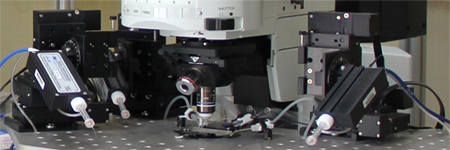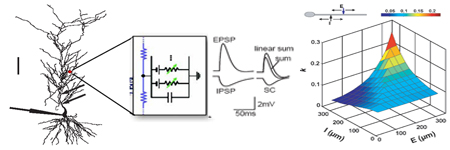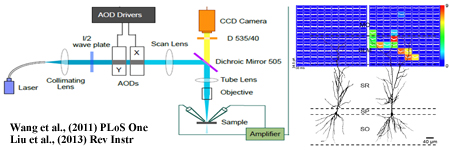Methods and Experimental Resources
We use and develop multiple neurosciece apporaches, consisting of: ,
- in vivo Whole cell or extracellular recording in the anesthetized or awaking animals.
- in vivo Two-photon imaging (and guided physiological recording).
- Whole-cell patch-clamp recording of synaptic transmission in acute brain slices in intro .
- Optogenetic ChR2-assisted synaptic circuit mapping (CASCM).
- Conventional immunohistochemistry and neuronal morphology reconstruction/analysis.
- Realistic NEURON model simulation.
Resource: Electrophysiology recording

The patch-clamping technique is an extremely powerful and versatile method
for studying electrophysiological vocabularies of biological systems, including membrane excitability and neuronal transmission. The patch-clamp setups vary among different laboratories, reflecting the diversity of experimental requirement or the foibles of the experimenter. A patch-clamp or extracellular recording rack requires the below 4 main concerns:
(1) Environment: the means of keeping the preparation healthy;
(2) Optics: the means of visualizing the preparation;
(3) Mechanics: a mean of stably positioning the microelectrode;
(4) Electronic: a mean of amplifying and recording the signal.
We here list the webpage links to different manufacturers that provide the essential equipment for recording racks. Our lab has the experience in using nearly all of them.
Recording Instruments' Links
Isolation Table: Newport;
Technical Manufacturing Corp.
Microscopy: Nikon; Olympus;
Zesis; Leica
Microscopy Translator and Isolating Platform: Burleigh;
Sutter Instrument Company
Patch-clamp amplifiers: Molecular Deviences-Axon Instruments ;
Heka
Micromanipulators:
hydraulic: Narishige;
Newport
motorized: Newport; Siskiyou
Design Instruments
peizoelectric: Burleigh;
Sutter Instrument Company
Microelectrode
Puller and Microforges: Narishige;
Sutter Instrument Company
Microelectrode
holders and accessories: Warner Instruments Corp.
Pulse Generator: A.M.P. Instrument;
Cygnus Technology, Inc
Oscilloscope:Tektronix; Gould Instrument system
Infar-red CCD for Microscopy: Hamamatsu
Glass Capillaries: Sutter Instruments, Inc;VWR; Harvard Apparatus; World Precision Instruments
AD/DA Converter:Axon Instruments
Data Acquisition and Analysis Software: Axon
PClamp; Axon Axoscope (free);
Whole-cell
recording Program (free, by J. Dempster,
Univ. Starthclyde, UK); MiniAnalysis;
Origin; SigmaPlot;
DataWave CP Analysis;
....and more homemade equipment.
Resource: Realistic NEURON simulation & Dendritic morphology analysis

The basic information and simulation pogram of NEURON can be found at it resource website at Yale University, http://www.neuron.yale.edu/neuron/resources/. Here we provide our NERUON simulation codes for our studies on dendritic integration of exciatatory and inhibitory synaptic inputs at the apical dendrite or the axonal initial segement (AIS) of a pyramidal cell. The related results are published in the PNAS (Hao et al., 2009), or in preparation.
Resource: Optogenetic tools and CASCM

Optogenetics offer powerful tools for the interrogation of neural acitivty of circuits underlying specific behaviours and mapping synaptic connections of the brain. A informative optogenetics resouce center can be found at the D-Lab website, http://web.stanford.edu/group/dlab/optogenetics/index.html. Here we provide some useful links of optogenetic tools in the mainland of China, including harewares, viral preparation, and related mice lines. Our lab has these resouces, and some of them can be provided to other labs upon the request.